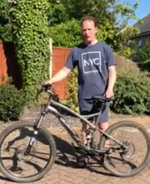-----
Readers familiar with Parkinson’s may have seen the video taken in a Dutch hospital showing a patient with mobility issues, struggling to walk even a few steps but then getting on his bike and cycling freely, seemingly unimpaired by his Parkinson’s. The contrast shown in these video clips seems extraordinary; at first a hesitant, slow, shuffling walking movement, followed directly by cycling with a balanced fluidity of motion where one would not guess at any impairment at all. Many PD patients will be familiar with this miraculous, freedom of movement offered by riding a bicycle.
Cycling, Running, Stairs
There are other equally extraordinary aspects of movement that can be seen in PD; walking is often extremely difficult and very slow, each step feels like moving through treacle compounded by balance issues. But, within a second, one can then run fast – without effort, in a straight line and with complete balance and control, arms swinging freely. In fact, running in a manner indistinguishable from that of a healthy person.
Stairs or steps can represent a challenge for some patients at a certain stage of this progressive condition, whereas for others they highlight a further baffling aspect of movement in Parkinson’s. Walking on the flat is problematic whereas once stairs are reached, free-flowing steps can be taken without hesitation or the need for any support. This applies equally whether climbing or descending a staircase. A friend recently suggested to me that if this is the case, I should get some modifications made to my house incorporating the design principles of MC Escher.
Reverse Direction?
When tired or when late in the evening, or when one’s medication is wearing off, each forward step can seem interminable, waiting, hoping for sufficient motive force to build and allow one to lift then place one foot in front of the other. Such frustrating efforts may result in the gaining of just a few inches, leaving one to consider if the bedroom or bathroom will ever be reached that day. The psychological factor of anxiety can then intrude to further increase hesitancy, and slow progress. Under these circumstances, I often find it useful to turn-around and walk backwards. I can then move at near-normal walking speed, although the risk of encountering unseen objects on the floor and the laughter of loved ones needs to be endured. And of course, it’s hard to see a neurologist or physiotherapist recommending this approach.
It seems truly bizarre that walking backwards, climbing stairs, or running at full-speed should prove to be significantly easier than walking normally, on the flat, in the forward direction. But that is the case for myself, at my current stage of this disease.
Bike Mobility Tip
Returning to cycling and looking to benefit from physical exercise that is so important for PD sufferers, there is one important obstacle to overcome: getting on and off the bike. For casual riding, keeping the saddle in a lowered position works fine. But to gain maximum benefit from exercising hard, a saddle needs to be at a sufficient height that the legs are more or less straight when the pedal is at the bottom of its stroke. The required seat height to achieve this inevitably increases the fear of toppling over when stopping at junctions or when cycling slowly up a hill. Getting on and off the bike also becomes very challenging with stiff Parkinson’s legs.
An invaluable solution for these problems was suggested to me by my sister, a keen mountain biker. She proposed using a gadget familiar to the mountain biking community, known as a dropper seatpost. Its purpose in mountain biking is to allow the saddle to be lowered on a steep descent enabling the rider’s weight to be shifted backwards. Whilst not excluding this purpose for Parkinson’s patients, it also proves fantastically useful to help getting on and off a bike and increasing confidence when approaching road junctions.
Dropper posts operate quite simply through a button on the handlebars allowing the saddle to be raised or lowered 10–15 cm. This adjustment of seat-height can be operated whilst in motion or when stationary. It greatly assists getting on and off the bike and gives confidence when cycling slowly, in the lowered position, then raised once some momentum has been gained, allowing powerful cycling strokes.
This simple device could allow many Parkinson’s sufferers to return to cycling, or take it up, and provide physical exercise shown to be so important. Equally important in facilitating greater participation in cycling is the huge psychological benefit that it provides, entirely removing the limitations and frustrations inherent in walking, giving a great sense of freedom and autonomy.
Please contact me for further information on how to select a suitable dropper post and how to best configure for each individual’s circumstances. View a short video of the dropper post in action here.
Watch out for a subsequent blog post highlighting recent technological developments that assist the PD cycling community.








- Comment
|